Building Content Plans Around User Intent
Building a high authority site is the ultimate goal of every content strategist. However, the traditional approach to content strategy, which focuses solely on keyword search volume and competition, may not be enough to achieve this. In this article, I explore a different perspective on content planning – one that revolves around user intent.
By understanding and addressing the various intents behind user queries, you can create a comprehensive content plan that covers all possible angles and establishes topical authority. Let’s dive into the concept of user intent, explore explicit intent, intent fracture, and topic ambiguity, and learn how to build content plans that truly resonate with our audience.
We know from Google’s Search Quality Evaluator Guidelines (pdf) and their many search patents that authoritativeness plays an important role. Bill Slawski has a wonderful site that explores the implications of Google’s search patents. I encourage you to read it to gain a better understanding of where search is heading.
It’s time to shift our focus from keywords to user intent and take our content strategy to the next level.
Here’s what I mean.
The Typical Content Strategy
The common approach to content strategy looks at keywords using two variables – keyword search volume and competition. Plotting keywords in a matrix leaves only four possible choices:
- high volume and high competition
- low volume and high competition
- low volume and low competition
- high volume and low competition.
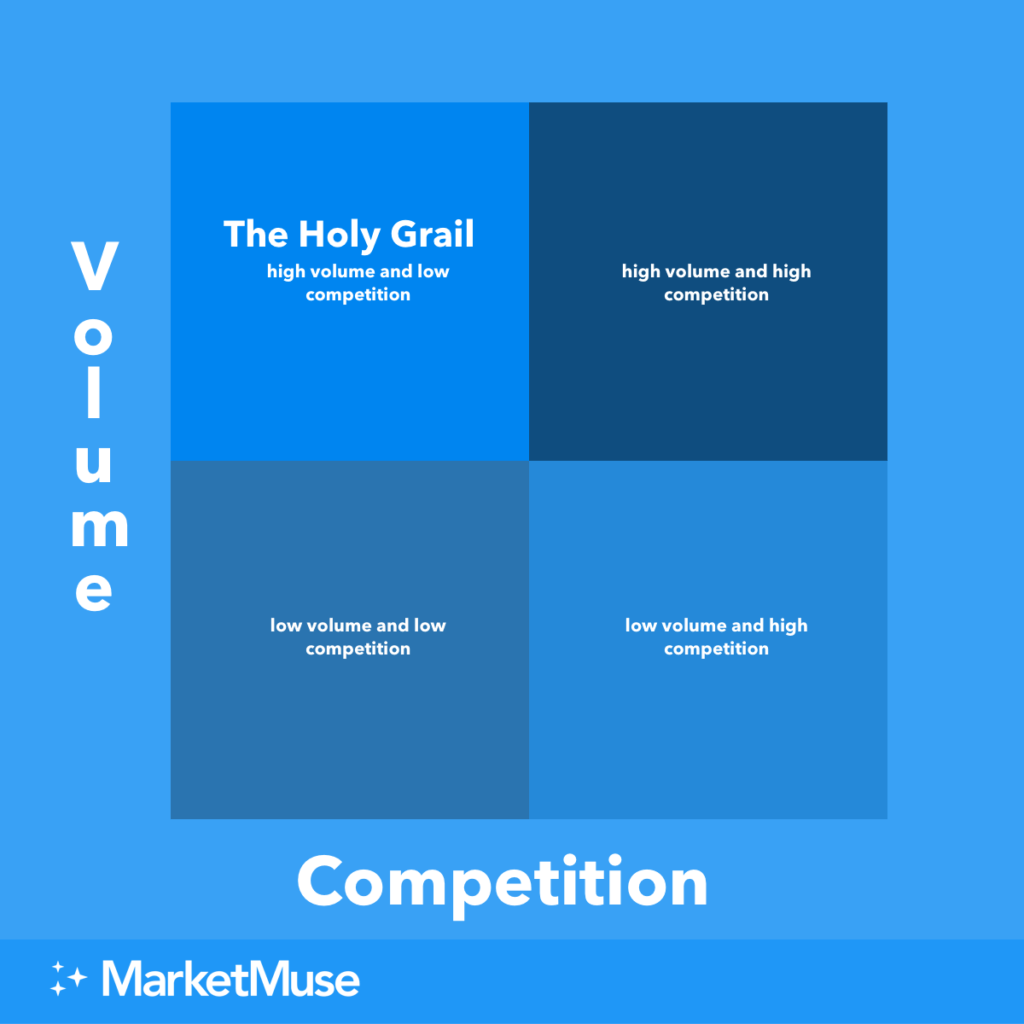
What gets the most attention in this situation are keywords with high volume and low competition. These are the Holy Grail of keywords sought after by every content marketer taking this approach.
You can see the problem though, can’t you?
Those high volume and low competition keywords that everyone is going after quickly turn into high volume, high competition keywords. I’ve been there done that! ?
But I’m not the only one to realize that using search volume as a North Star has short comings. As Jason Firch observes, “keyword research is more nuanced than just selecting the highest volume phrase.”
There’s another problem too.
Most sites pursuing this approach end up struggling to gain any authority whatsoever. Their endless pursuit of the mythical high volume, low competition keywords leaves them with a disjointed collection of pages that often bear little relation to each other.
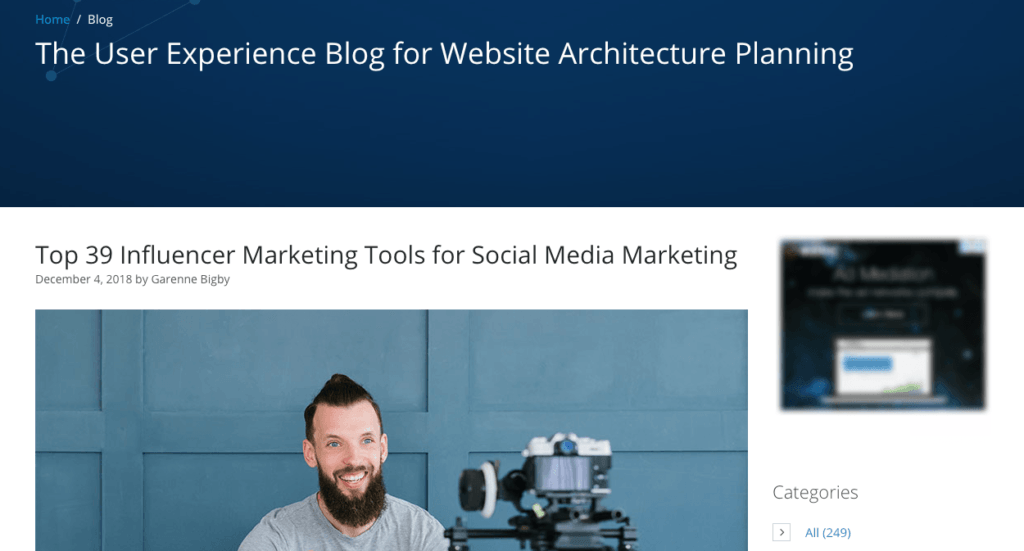
Blogs like this often suffer from topic drift. It’s how you end up with a “user experience blog for website architecture planning” talking about “influencer marketing tools for social media.”
Awkward? Yes.
But it’s worse than that.
Failing to address all possible intents of a topic results in a site that suffers from a severe case of content gaps. Content gaps have an inverse relationship with authority– the more gaps you have, the less authority you possess.
Build authority by abandoning the keyword volume/competition approach and focus on creating content that covers all possible intents.
Recognizing Explicit Intent, Intent Fracture, Topic Ambiguity
Before building a plan, we need to carefully investigate each focus topic to understand whether we’re dealing with explicit intent, intent fracture or an ambiguous topic. Let’s start with explicit intent because it’s the easiest to determine.
Explicit Intent
In the case of explicit intent, it’s evident that only one reason exists for the query. This type of query is typically very focused and specific, making it easy to map to a specific phase in the buyer journey.
Take for example the query “2018 dodge caravan tire size.” It’s a very distinct query with an identifiable problem and an intent that has been determined. It’s an obvious request for some specific information.
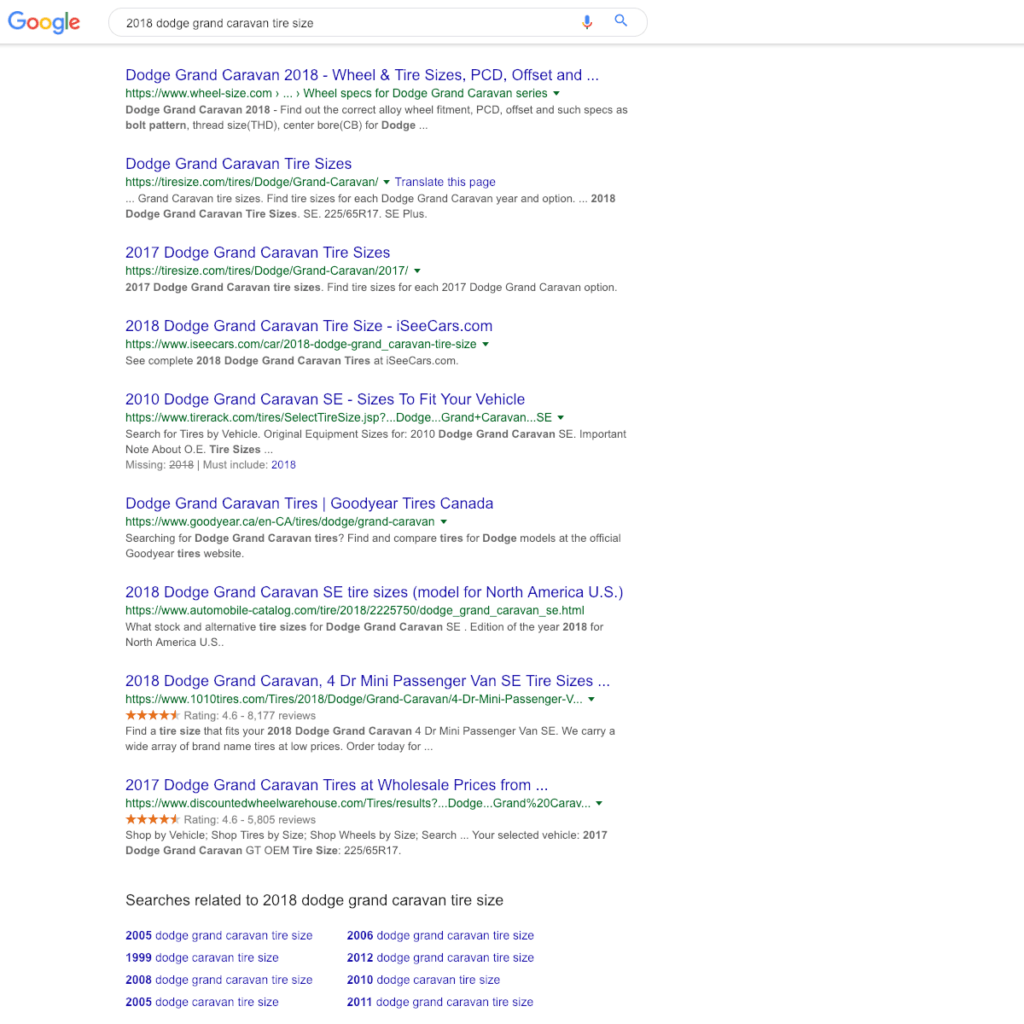
If we were to plot this intent to a content plan, we could map it to the Consideration phase while simultaneously ensuring we have content mapping to the Purchase phase. After all, someone searching for the tire size of a specific vehicle is most likely close to purchasing.
Unfortunately, things usually aren’t this simple.
Intent Fracture
There are often multiple reasons someone is searching for a given topic. This frequently happens with head terms – those are more general terms that are typically accompanied by high search volume.
Let’s use the query “content marketing” as an example. There are many possible intents associated with this topic including:
- Content marketing definition
- Content marketing best practices
- Content marketing use cases
- Content marketing news
- Content marketing software vendors

With so many possibilities, you can’t simply map the query “content marketing” to a specific place in the buyer journey. It covers too many outcomes.
So a pillar page on the topic of content marketing would need to cover all of the intents. Given how broad this topic is, you would need to build a plan around this pillar page covering all of those intents in a cluster of content.
Topic Ambiguity
Topic ambiguity exists due to the vagueness of language and presents a significant challenge to content strategists. This ambiguity is evident in search queries that provide results for two or more distinctly different entities.
For example, bat could refer to a number of entities including the mammal, British American Tobacco, Basic Attention Tokens, or a baseball bat.
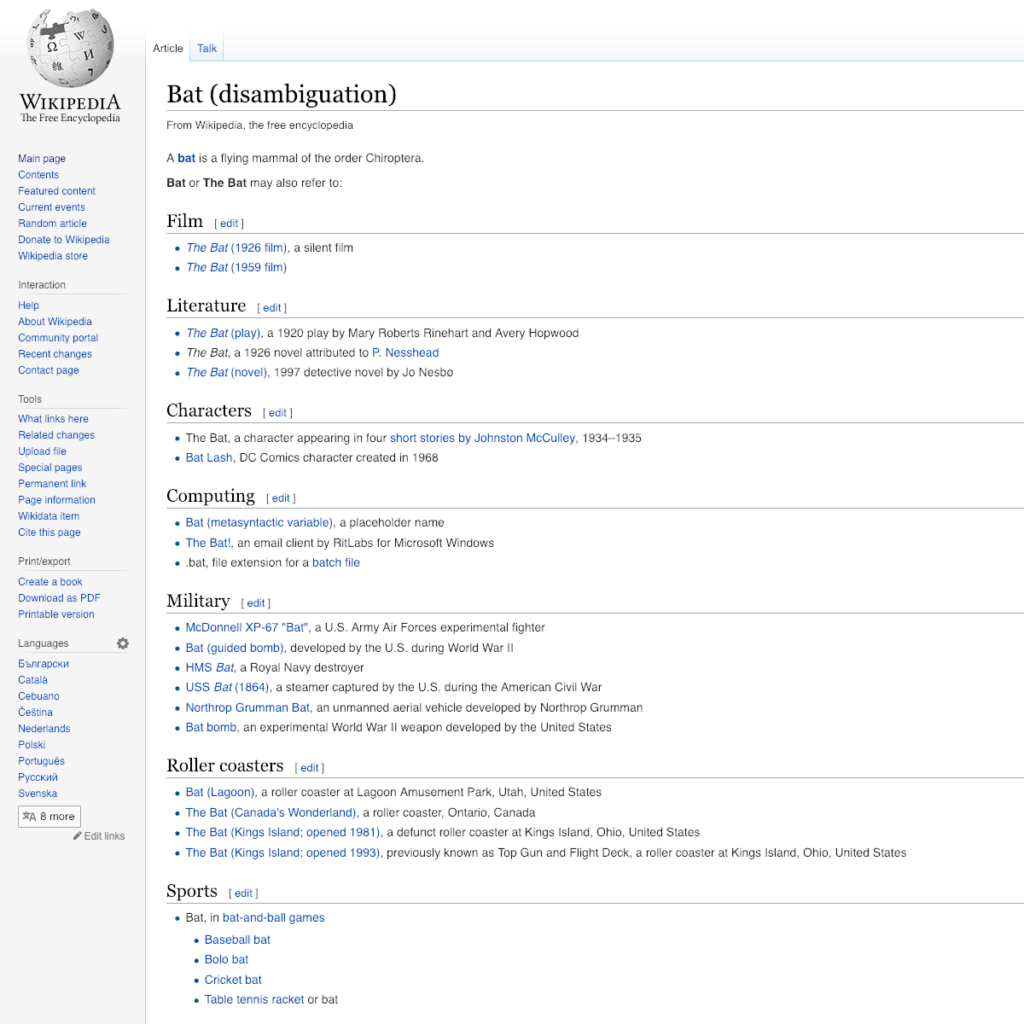
It’s difficult to disambiguate topics in situations like this, as revealed in the search results. One solution is to find modifiers and more specific terms and focus on ranking for those terms searched by your audience.
So, if you’re targeting bats (the mammal) then “do bats make good pets?” and “are bats safe to have around?” are more appropriate terms to target.
Beware of Favored Intent
Clear intent does not necessarily make life any easier. Favored intent is the intent that shows up on the first page of the SERPs and Featured Snippets.
Content strategists mistakenly assume that it’s the only intent they need to consider. But that’s like letting the tail wag the dog.
A favored intent isn’t necessarily the only intent. In fact, unified favored intent can often conceal a high degree of intent fracture.
Take the word “anthropomorphism” as an example. A search for this term reveals that an overwhelming number of entries on the first page are definitions of the word.
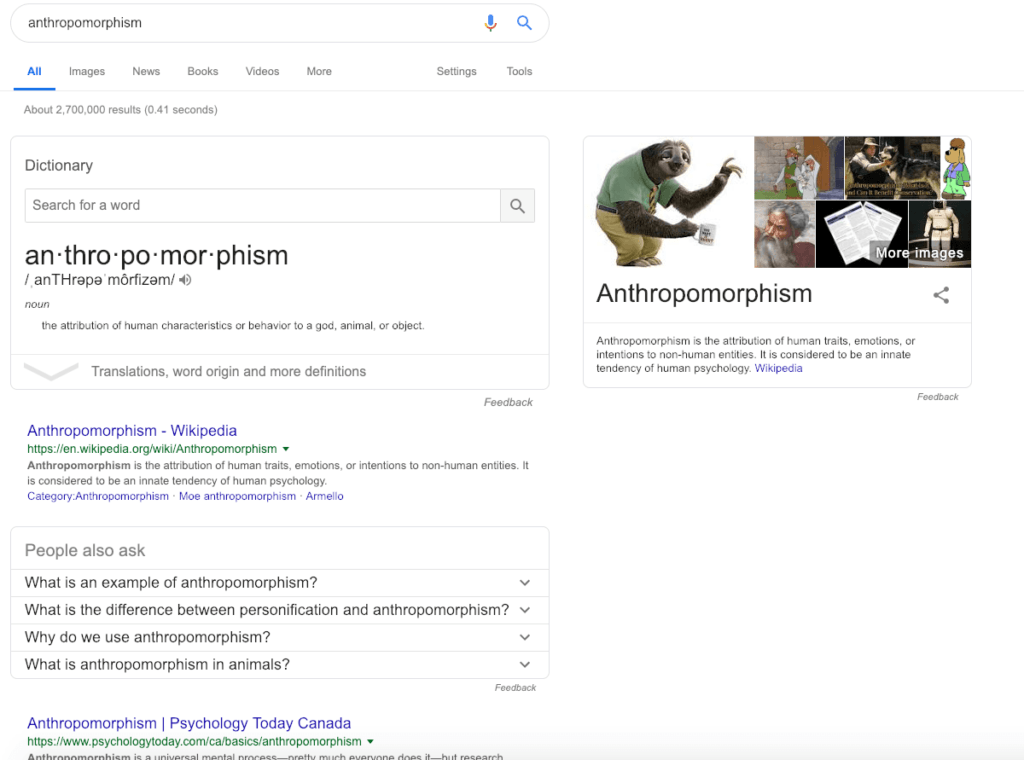
Google has determined that this is the most likely intent. So at first glance, the intent appears to be unified.
But you’re wrong if you think you can rank highly by just providing a page that satisfies Google’s favored intent. No matter how “better” you think your definition is, there’s a lot more that needs to be done.
As a content strategist tasked with the objective of getting your site recognized as an expert on anthropomorphism, you need to build content inventory and a site structure that positions you as the expert on that term.
You’ll need to demonstrate that authority by targeting keyword variants that cover all of the user intents in the topical area and links them together with a logical cluster-based linking strategy. Think about relevant topics, not keywords.
That’s what Google is looking for.
In that vein, your pillar piece focusing on “anthropomorphism” should cover those other intents. Ideally, you’ll cover them at a basic level. Then link to clusters of content that provide greater depth on the long-tail variants and intents.
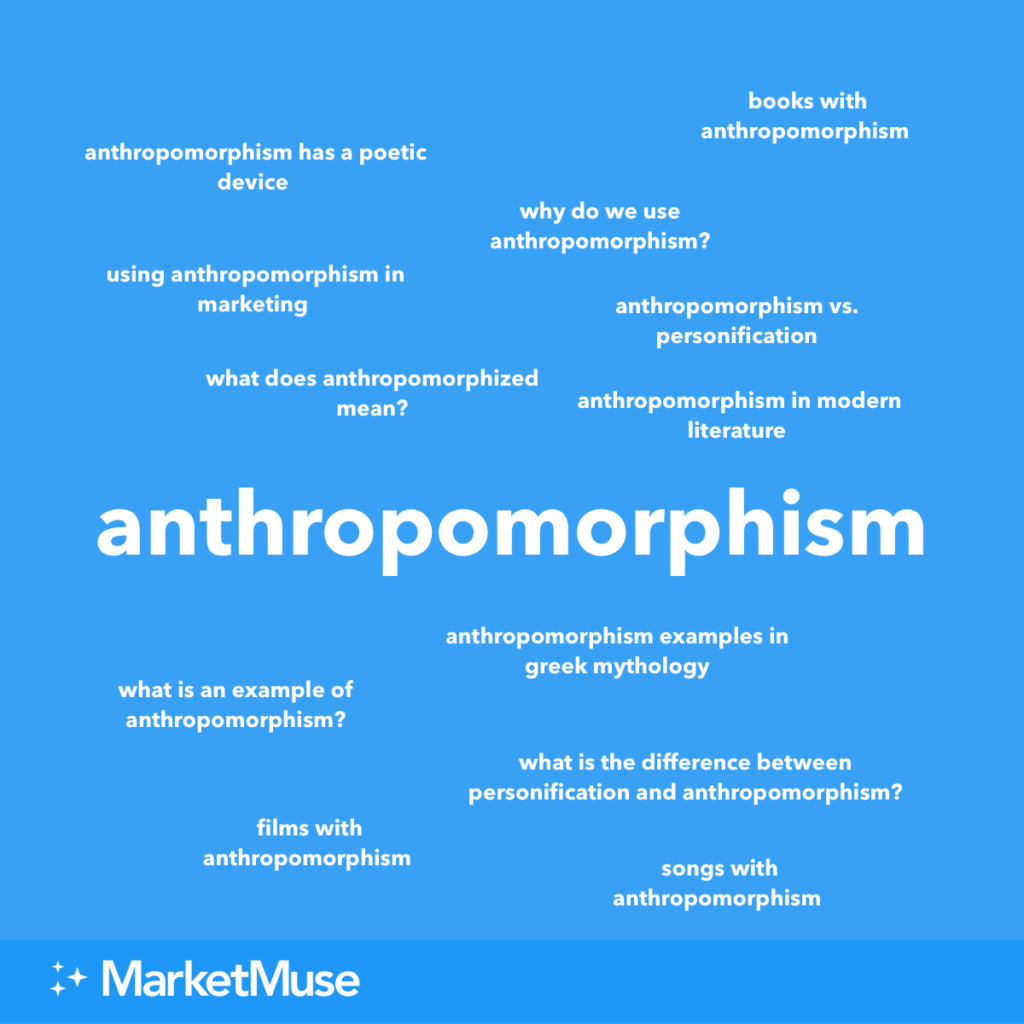
You still have to do intent mapping even if the favored intent in Google is unified. Unified favored intent in a Google SERP does not mean intent isn’t fractured.
Seeing unified intent for a general term should raise a red flag and cause you to look for additional variants and intents that aren’t being surfaced in the SERP.
Manually Mapping Intent Fracture
Now that we have a good handle on how to deal with search intent and ambiguity, it’s time to start mapping.
- Grab your favorite keyword tool and find variant keywords on a topic or one that’s closely related. Most keyword tools are pretty good at generating a lot of variants, but be careful. A high number of variants indicates greater fracture.
- Map variants into groups based on the customer journey. Use whatever grouping you’re most comfortable with and be consistent in your mapping:
- Awareness, Consideration, Purchase
- Do, Know, See, Go
- Informational, Commercial, Transactional, Local
- Be careful when mapping highly fractured topics. Associating it 1-to-1 with a specific intent profile can be dangerously misleading. Referring back to the “content marketing” query example, you can’t map this query to one particular stage. You need content that maps to multiple stages, regardless of the favored intent.
- Ensure you have sufficient content planned to cover the entire intent model comprehensively.
- Two questions you’ll need to address are:
- How fractured is the topic?
- How can we translate that into a plan that services the content creation need across all stages of the funnel?
Building Content Plans Around User Intent
So far, so good. But the real challenge for a content strategist is turning user intent from a pile of data into something that’s actionable.
Tell the Story of Intent
Tell the story of intent for a given topic by showing fracture in an actionable way. Describe the intent that lives within a given topic, in addition to special intents that should be surfaced.
Take the query “What is content strategy?” as an example. It’s quite explicit and can be mapped to Awareness or Informational depending on the model you want to use.
But broaden the topic to “content strategy,” and you’ll need a different approach, one that addresses the topic variants. It’s fractured, so how do we make this actionable? In order to own this term, you have to cover a lot of intents in the topical area of “topic modeling.”
Start Building Intents in Groups.
To make the intent fracture actionable, group the variants into maps, and give insights on the favored intent.
- Find intent fracture on a given topic.
- Group the various intents by user journey phase.
- Give insights on favored intents without using them as a crutch.
- For explicit intents, don’t get hung up on being super granular.
For a “What is” query, it’s Awareness or Informational depending on the model you use. Don’t get stuck trying to find super explicit intents and start saying things like “This is Awareness, Informational, Early Stage, Implementation-focused.”
Find Intent Gaps
Find keyword variants, which touch on different intents, that are missing from your existing inventory.
Is a page that’s ranking well for a given variant actually about that variant? If not, there’s an intent mismatch. You’ll need to optimize that page to better serve the user intent.
Is there an intent that’s simply not being served? You’ll need to create content to address that deficiency.
Look for Content Gaps
If somehow you’re ranking well for a general term but have failed to cover the fractured intents, run down the list of those variants and plan to optimize existing pages or create new content.
Look for Areas of Consolidation Based on Intent Grouping
This happens more often than you might realize. Frequently it happens where a site, sometime in the past, optimized each page for a specific keyword variant. You end up in a situation of having separate pages for “best content marketing software” and “top content marketing software.”
That’s not good since both pages serve the same intent. You’re not looking to establish a 1-to-1 relationship with every possible keyword variant. The goal is to cover all intent groupings comprehensively.
Take Aways
If your content strategy is based primarily on keyword volume and competition, it’s time to re-evaluate the situation. Look beyond individual page rankings and consider your site as a whole. Building topical authority comes from creating sufficient high-quality relevant content that addresses all possible user intents.
What you should do now
When you’re ready… here are 3 ways we can help you publish better content, faster:
- Book time with MarketMuse Schedule a live demo with one of our strategists to see how MarketMuse can help your team reach their content goals.
- If you’d like to learn how to create better content faster, visit our blog. It’s full of resources to help scale content.
- If you know another marketer who’d enjoy reading this page, share it with them via email, LinkedIn, Twitter, or Facebook.
Stephen leads the content strategy blog for MarketMuse, an AI-powered Content Intelligence and Strategy Platform. You can connect with him on social or his personal blog.